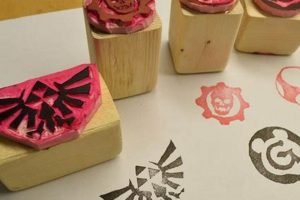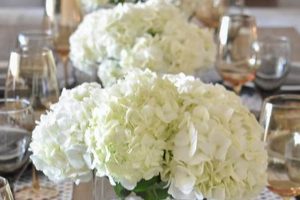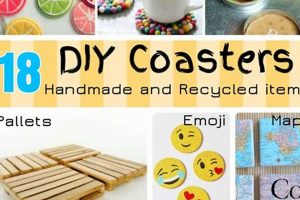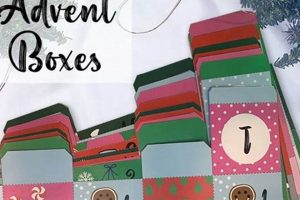Constructing personalized headwear for celebratory occasions represents a creative and cost-effective alternative to commercially produced items. These handcrafted adornments, often involving readily available materials such as paper, cardboard, fabric scraps, and embellishments, provide a unique aesthetic touch to festive gatherings. For instance, a child’s birthday party might feature conical hats decorated with glitter and themed imagery relevant to the celebrant’s interests.
The creation of individualized headwear offers numerous advantages. From an economic standpoint, it reduces expenses associated with event planning. Furthermore, it fosters creativity and allows for the expression of personal style, contributing to a more memorable and personalized celebration. Historically, the practice of wearing special head coverings during festivities dates back centuries, signifying status, commemorating events, or simply adding to the celebratory atmosphere.
Subsequent sections will explore various techniques for crafting these celebratory accessories, detailing material selection, construction methods, and decorative approaches to enhance the aesthetic appeal and durability of handmade party headwear.
DIY Party Hats
The following recommendations address key aspects of creating durable, aesthetically pleasing, and cost-effective decorative headwear for festive occasions. Adherence to these principles will enhance the overall quality and suitability of the finished product.
Tip 1: Material Selection. Prioritize the use of robust base materials such as cardstock or stiff felt to ensure structural integrity. Lightweight paper may require reinforcement. For embellishments, consider the age group and potential hazards associated with small, detachable items.
Tip 2: Accurate Measurement and Sizing. Precise head circumference measurements are crucial for ensuring a comfortable and secure fit. Employ adjustable closures, such as elastic bands or ribbon ties, to accommodate variations in head size.
Tip 3: Secure Adhesion. Utilize high-quality adhesives specifically designed for the chosen materials. Avoid using excessive amounts of glue, which can compromise the appearance and structural integrity of the finished hat. Allow adequate drying time.
Tip 4: Reinforcement of Stress Points. Pay particular attention to reinforcing seams and attachment points, especially in areas subject to frequent handling. Consider using additional layers of material or strategic stitching to enhance durability.
Tip 5: Thematic Cohesion. Integrate design elements that align with the overall theme of the event. Color palettes, patterns, and embellishments should complement the existing dcor and contribute to a unified aesthetic.
Tip 6: Balanced Proportions. Maintain a harmonious balance between the size and shape of the hat and the wearer’s physical characteristics. Overly large or disproportionate designs may appear cumbersome or visually unappealing.
Tip 7: Edge Finishing. Implement techniques for neatly finishing the edges of the hat to prevent fraying and enhance the overall appearance. Options include edge binding, scalloping, or decorative trimming.
By consistently implementing durable construction, appropriate measurements, reinforcement techniques, and thematic choices, individuals can ensure the final product achieves professional quality.
The subsequent segment will discuss how to effectively utilize existing materials and recycling ideas during the construction process.
1. Material Durability
The longevity and usability of handcrafted celebratory headwear are directly contingent upon the selection of materials possessing inherent durability. Inadequate material strength results in products that are susceptible to tearing, bending, or structural collapse, thereby diminishing their practical value and aesthetic appeal. The cause-and-effect relationship between material quality and the lifespan of these items is demonstrably clear: robust materials yield enduring products, while flimsy alternatives lead to premature degradation.
The importance of material durability is particularly pronounced in scenarios involving children. For instance, a party hat constructed from thin paper is likely to succumb to damage from handling, rendering it unusable within a short timeframe. Conversely, a similar hat crafted from cardstock or reinforced felt exhibits greater resistance to wear and tear, allowing for extended use and enjoyment. The selection of materials also influences the ability to incorporate decorative elements effectively. A durable base provides a stable platform for adhering embellishments, preventing them from detaching easily.
Understanding the practical significance of material durability allows for informed decision-making during the creation process. By prioritizing materials with inherent strength and resilience, individuals can produce celebratory headwear that withstands the rigors of use and provides lasting value. This understanding directly addresses the challenge of creating sustainable and cost-effective decorations, aligning with broader themes of resource conservation and mindful consumption.
2. Secure Fit
A secure fit constitutes a fundamental component of successful homemade celebratory headwear. The stability of the headwear directly impacts its wearability and functionality. An ill-fitting hat, prone to slipping or falling off, presents a distraction and detracts from the celebratory atmosphere. The correlation between proper fit and user satisfaction is demonstrably strong: a comfortably secured hat is more likely to be worn and enjoyed throughout the duration of the event.
In practical terms, achieving a secure fit requires careful attention to measurement and adjustment mechanisms. Inaccurate head circumference measurements inevitably lead to improperly sized headwear. Elastic bands, ribbon ties, or adjustable straps serve as crucial elements in accommodating variations in head size and ensuring a snug, yet comfortable, fit. For instance, consider a child’s birthday celebration where participants are actively engaged in games and activities. A hat that lacks adequate securing mechanisms is likely to become dislodged during movement, causing frustration and potentially disrupting the flow of events. Conversely, a well-fitted hat remains securely in place, allowing for unencumbered participation and enjoyment.
The practical significance of a secure fit extends beyond mere comfort and convenience. It also addresses safety concerns, particularly in environments where movement is prevalent. A securely fitted hat reduces the risk of accidental displacement, minimizing potential tripping hazards or interference with vision. Prioritizing this element in the design and construction phase elevates the quality and usability of the finished product, ensuring it serves its intended purpose effectively and
safely, thus underscoring the importance of meticulously considering the means of fastening within the design.
3. Design Cohesion
Design cohesion, in the context of handcrafted celebratory headwear, refers to the unified and harmonious integration of all visual elements, including color palettes, patterns, embellishments, and overall form, to create a singular, aesthetically pleasing object. The presence or absence of design cohesion directly impacts the perceived quality and appropriateness of the headwear for its intended purpose. A lack of cohesion results in a visually disjointed and potentially jarring appearance, diminishing the item’s overall appeal, while strong cohesion elevates the headwear, enhancing its visual impact and contributing to the overall celebratory atmosphere.
The practical application of design cohesion is evident in the selection and arrangement of decorative components. For example, consider a themed event such as a nautical-themed birthday party. Cohesive design principles dictate that the headwear should incorporate elements consistent with the chosen theme, such as blue and white color schemes, nautical motifs (anchors, sailboats), and rope or netting embellishments. Deviation from these elements, such as the inclusion of unrelated patterns or colors, disrupts the thematic unity and detracts from the overall aesthetic. Conversely, meticulously curated design choices reinforce the intended theme and create a visually engaging and immersive experience for the wearer and observers.
Understanding the significance of design cohesion enables crafters to make informed choices regarding material selection, embellishment placement, and overall form. By prioritizing thematic consistency and visual harmony, individuals can produce celebratory headwear that not only serves its functional purpose but also contributes meaningfully to the aesthetic of the event. This understanding addresses the challenge of creating visually compelling and contextually appropriate decorations, fostering a more immersive and memorable celebratory experience.
4. Adhesive Strength
Adhesive strength is a critical determinant of the structural integrity and longevity of handcrafted celebratory headwear. The efficacy of the adhesive directly influences the secure attachment of various components, including embellishments, seams, and structural reinforcements. Insufficient adhesive strength precipitates detachment, compromising the hat’s aesthetic appeal and functional utility. The relationship between adhesive quality and the overall durability of headwear is demonstrably causal: robust adhesion yields resilient products, while weak bonding leads to premature failure.
Consider, for instance, the application of glitter or small decorative elements to a paper-based party hat. If the adhesive employed lacks sufficient bonding strength, these embellishments are prone to dislodging with minimal handling, particularly by children. This not only diminishes the hat’s visual appeal but also presents a potential choking hazard. Conversely, utilizing a high-quality adhesive, specifically formulated for bonding diverse materials, ensures a secure and lasting attachment, extending the lifespan of the headwear and minimizing safety risks. Further, strong adhesion between seams ensures the hat maintains its intended shape, resisting deformation and premature wear. The selection of an appropriate adhesive thus transcends mere aesthetic considerations, directly impacting the safety, durability, and overall value of the finished product.
Understanding the practical significance of adhesive strength empowers crafters to make informed material choices and employ appropriate bonding techniques. By prioritizing adhesives with proven efficacy and adhering to recommended application procedures, individuals can produce celebratory headwear that withstands the rigors of use and provides lasting enjoyment. This understanding directly addresses the challenge of creating durable and safe decorations, aligning with broader principles of responsible crafting and resource conservation. Failure to acknowledge the importance of adhesive strength inevitably results in inferior products and potential safety hazards, underscoring the critical role it plays in the successful creation of handcrafted party accessories.
5. Embellishment Safety
The secure attachment of decorative elements is paramount in the context of handcrafted celebratory headwear, particularly when intended for use by children. The selection and application of embellishments to headwear necessitates a rigorous assessment of potential hazards, primarily focusing on the risk of detachment and subsequent ingestion or aspiration. The causal relationship between insecurely affixed decorations and adverse health outcomes is demonstrably direct: poorly attached embellishments pose a significant safety risk, particularly among younger demographics.
Consider, for instance, the common practice of adhering small beads, sequins, or glitter to paper-based or fabric-based headwear using glue or adhesive tape. Inadequate bonding strength, coupled with the inherent fragility of these materials, can result in the detachment of these items during normal use. A child, attracted by the shiny appearance of a detached sequin, may instinctively place it in their mouth, leading to a choking hazard or potential gastrointestinal distress. To mitigate these risks, larger embellishments should be used when possible; if not, robust adhesives designed to bond diverse materials can enhance safety by ensuring decorations are securely attached and are less likely to be dislodged during use, even with rough handling. Also, consider options such as embroidery, which offer inherently stronger attachment than adhesives. Moreover, the presence of small parts should be minimized, and edges should be rounded to reduce the likelihood of scratching or cutting.
Therefore, a thorough understanding of the potential risks associated with embellishments is indispensable for ensuring the safety and usability of handcrafted party headwear. By prioritizing non-toxic materials, secure attachment methods, and age-appropriate design principles, individuals can significantly reduce the likelihood of adverse events and create celebratory accessories that are both aesthetically pleasing and demonstrably safe. This approach aligns with broader principles of responsible crafting and emphasizes the importance of proactive risk mitigation in the creation of items intended for use, and especially by children.
Frequently Asked Questions
The following section addresses common inquiries regarding the creation of personalized headwear for celebratory events. The information provided aims to clarify best practices and address potential challenges associated with this craft.
Question 1: What materials are most suitable for constructing a durable base for celebratory headwear?
Cardstock, stiffened felt, and corrugated cardboard represent viable options for creating a structurally sound base. Lighter weight papers may require reinforcement to prevent tearing or collapse during use.
Question 2: How can a secure and comfortable fit be ensured when crafting personalized headw
ear?
Accurate measurement of head circumference is crucial. Elastic bands, adjustable straps, or ribbon ties provide flexibility in accommodating variations in head size and ensuring a snug yet comfortable fit.
Question 3: What adhesives are recommended for bonding various materials in the creation of these headwear items?
High-quality craft glues, hot melt adhesives (used with caution), and fabric glues are suitable choices, depending on the materials being joined. It is imperative to select an adhesive formulated for the specific material combination.
Question 4: How can the risk of embellishment detachment, posing a safety hazard, be minimized?
Utilize robust adhesives, secure embellishments with stitching where possible, and opt for larger embellishments over smaller ones, particularly when creating headwear intended for children. Thoroughly test the security of all attached elements before use.
Question 5: What design principles should be considered to achieve a cohesive and visually appealing final product?
Maintain thematic consistency, employ a harmonious color palette, and ensure proportional balance between the headwear’s size and the wearer’s physical characteristics. Overly elaborate or disproportionate designs may appear cumbersome or visually distracting.
Question 6: How can cost-effectiveness be maximized when sourcing materials for decorative headwear?
Explore the utilization of recycled materials, such as cardboard boxes, fabric scraps, and repurposed embellishments. Consider purchasing materials in bulk to leverage volume discounts and minimize per-unit costs.
In summary, successful creation of personalized celebratory headwear necessitates careful attention to material selection, adhesive properties, design principles, and safety considerations. Prioritizing these factors will enhance the durability, aesthetic appeal, and overall suitability of the finished product.
The subsequent section will explore advanced techniques for embellishing and personalizing these handcrafted accessories.
Conclusion
The preceding analysis has elucidated the multifaceted aspects of constructing personalized headwear for celebratory occasions. Emphasis was placed on material durability, secure fit, design cohesion, adhesive strength, and embellishment safety. Successful implementation of these principles results in durable, aesthetically pleasing, and functionally appropriate headwear.
The creation of diy party hats transcends mere cost savings; it represents an opportunity for creative expression and personalization within celebratory contexts. Continued adherence to the outlined guidelines will facilitate the production of high-quality, safe, and memorable additions to any festive gathering. The careful consideration of each element ensures that the final product not only enhances the event but also reflects the individual artistry of its creator.







